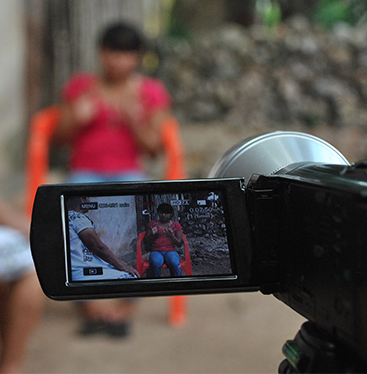PROJECT
The project started informally in 2009 supported by the Max Planck Institute for Psycholinguistics in Nijmegen (The Netherlands). . In 2013, the project got support from the
CIESAS and the INALI; Since, the documentation project has been increasing and produced scientific contributions. Currently, the research project is coordinated by Dr. Le Guen. The research project has documented YMSL in several villages in the Yucatec peninsula. First, Chicán and Nohkop but more recent investigations extended to Trascorral y Cepeda Peraza.
The overall aim of the research is to understand and explain the similarities that exist between Chicán and Nohkop at the linguistic level. To accomplish the research team makes use of new technologies handled by a group of experts and speakers, both Mayan speakers as well as YMSL signers (deaf and Bilingual-Bimodal).
The overall aim of the research is to understand and explain the similarities that exist between Chicán and Nohkop at the linguistic level. To accomplish the research team makes use of new technologies handled by a group of experts and speakers, both Mayan speakers as well as YMSL signers (deaf and Bilingual-Bimodal).
AN INNOVATIVE PROJECT
The project aims at improving Mexico’s scientific development in general, and to various linguistic communities in particular; as registered digital collections show evidence of an extreme contact between this native language and the Yucatec Maya spoken language as linguistic and cultural heritage.NEW LANGUAGES
The LSMY’s documentation contributes to linguistic documentation and to the topologic description of world languages. This is a great input to sign language linguistics and linguistics in general. The emergency from distinct sign languages in a spontaneous manner and isolated rural contexts are, no doubt, a unique opportunity to better understand the processes that led to the human language emergence.SOME QUESTIONS ABOUT THE RESEARCH
The recognition of emergent sign languages and their comparison in various communities allows providing potential answers to fundamental questions like: What are the universal traits of human language? Which language structure characteristics distinguish languages with visual-spatial modalities? And how the socio-cultural context influences the emergence of sign languages? PROJECT PHILOSOPHY

There is no better way to conduct the documentation and LSMY’s description than to incorporate signer persons and its users. That is why the research team has had worked very closely with the communities, sharing everyday activities; making use of participant ethnography, doing long and/or frequent fieldwork. In such a way, signers have been of great importance and they have been integrated to the research team, conducting video recording, transcription, and translation.
HOW WE DO ACHIEVE IT?
We dedicated a period of time to members' preparation, giving them tutoring on the ELAN’s software usage, basic linguistic lessons, and various courses regarding the utilization of recording materials.
As a way to fully demonstrate community members’ integration in the scientific process, members of the communities themselves featured lectures in the First Coloquio Internacional de las Lenguas Emergentes (First International Colloquium of Emergent Sign Languages) supported by INALI, which took place in Mexico City, September 2015. This experience was a success and young members of the project as well as students were able to clearly present innovative research but also answer questions and comments from international and senior researchers.
Finally, we want to emphasize among the members of the project, we utilize Spanish the least possible, not only because the team incorporates elderly people and signers, as native speakers do not consider Spanish as a common language, but also it is a way of promote and make visible the two indigenous languages (LSMY an spoken maya); In some respect, it also is a way to avoid any form of colonialism in which researchers would impose a language that is not the one of the collaborators.
PROJECT CONTRIBUTIONS
Documentation in different communities (initially Chicán and Nohkop but more recently Trascorral, Cepeda, and Chemax) has allowed us to find elements to understand.
ALL RIGHTS RESERVED ©- 2020 PLSMY
